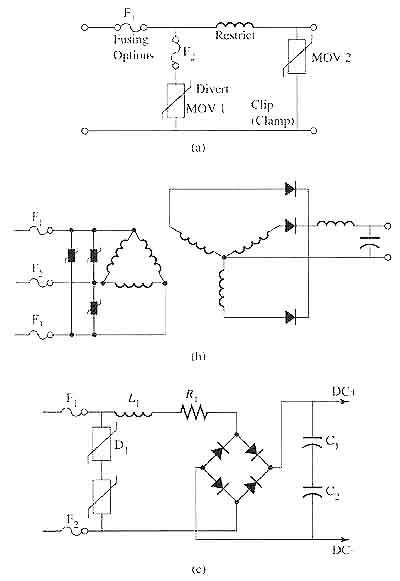AMAZON multi-meters discounts AMAZON oscilloscope discounts
The rectifier circuits in power supplies are subject to a large variety of transient voltages from lightning or from inductive loads such as motor and coils that produce a spike when they are de-energized. When these transients occur, they may have voltage levels that are two to five times the original supply voltage. The fuses in a circuit are designed to protect a circuit against overcurrent, but they can't detect overvoltage.
A solid-state device called a metal oxide varistor (MOV) is designed to be connected in parallel across the input power supply. Fig. 1 shows three diagrams of MOVs connected in power supply circuits. In Fig. 1a, notice that this circuit uses two MOVs. MOV1 is connected in parallel across the incoming voltage lines immediately after the mainline fuse. The MOV exhibits high resistance until its voltage rating is exceeded. This means that if the incoming voltage to the power supply circuit that the MOV is protecting is normal, the MOV will have very high resistance and act like an open circuit. If the incoming voltage increases to a point that exceeds the MOV's voltage rating, the internal resistance of the MOV is quickly reduced to near zero, which will allow maximum current to flow through it. Since MOV1 is connected directly across the two wires of the incoming voltage immediately after the main circuit fuse F1, the excess current that is flowing through the MOV will cause fuse F1 to open.

Above: Fig. 1 (a) Electronic diagram that shows two
metal-oxide varistors (MOVs). MOV1 is for protection against overvoltage
conditions from incoming voltage, and MOV2 provides surge protection against
transient voltages that may be produced in an inductive load. (b) Electronic
diagram that shows three MOVs connected in a three-phase power supply.
(c) Electronic diagram that shows two MOVs connected in a single-phase
power supply.
In some applications the F1 fuse must be sized as a time delay fuse so that inductive loads such as motors can draw locked rotor amperage (LRA) for several seconds when the motor is started. In these cases a second fuse (F2) that is faster acting is added in series with the MOV to protect it. When MOVI goes into conduction, the excessive current it draws will be sufficient to cause both fuses to open. Since fuse F2 is specifically designed to react fast enough to protect the MOV, the MOV will not be damaged by the overcurrent.
MOV2 is connected after the choke in this circuit so that it's parallel to the load. If excessive voltage occurs, the MOV will cause a short circuit which results in excessive current flowing through the choke. The choke will absorb some of this excessive current and protect the MOV until fuse F1 opens and clears the fault.
Fig. 1b shows a three-phase rectifier circuit with three MOVs. One MOV is connected across each incoming phase. If the voltage of any phase becomes excessive and exceeds the level of any MOV, the MOV will begin conducting current and cause sufficient current to flow so that the main fuses in the circuit will open.
Fig. 1c shows two MOVs connected across the single-phase lines for a
fullwave bridge rectifier. If the voltage that is supplied to the bridge
rectifier becomes excessive, the MOVs will go into conduction and cause
excessive current to flow, which will cause the main fuses to open.

